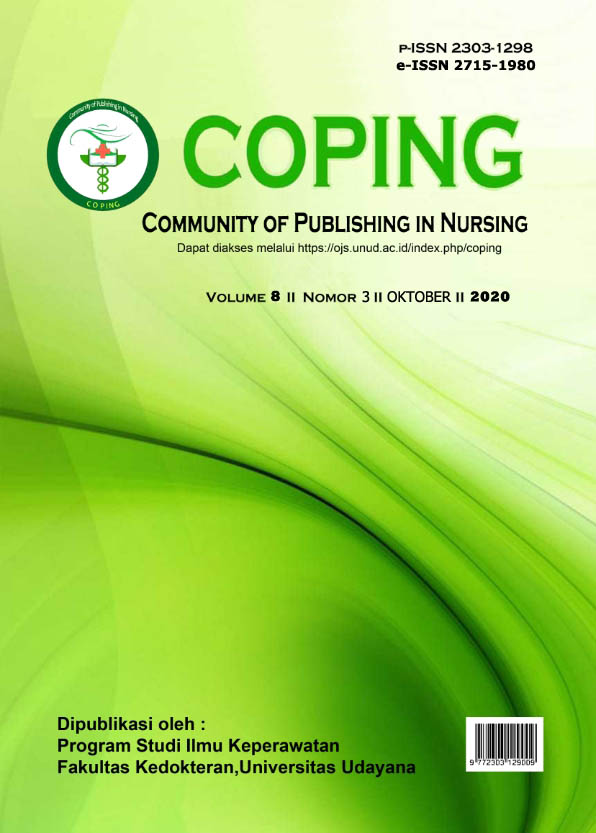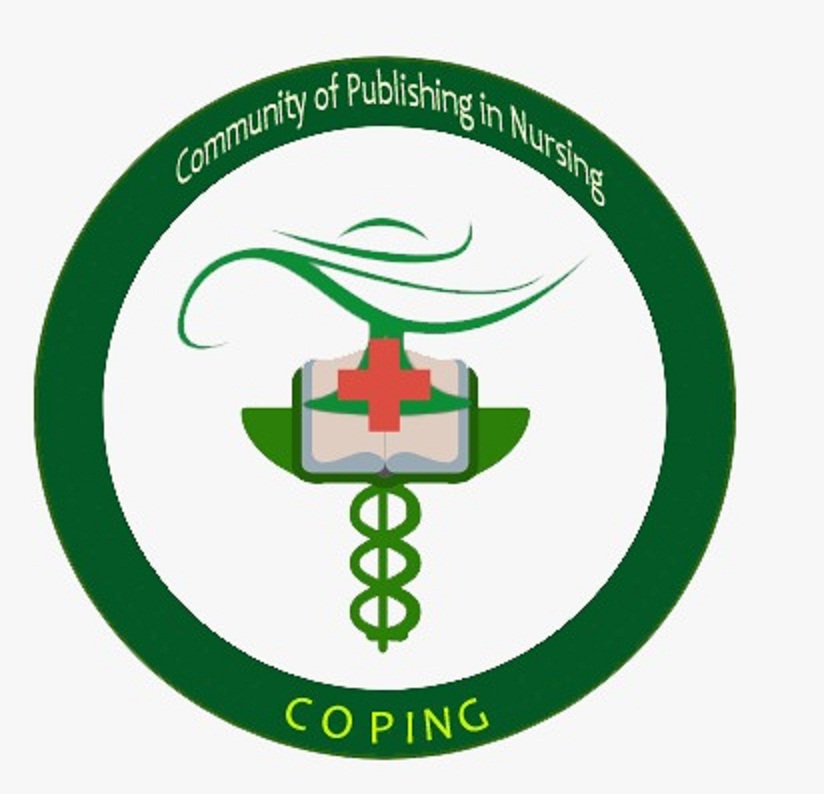GAMBARAN BERMAIN TERAPEUTIK SEBAGAI PENGALIHAN NYERI PADA PASIEN ANAK KANKER POST KEMOTERAPI DI RUMAH SINGGAH YAYASAN PEDULI KANKER ANAK BALI
Abstract
Pain is one of the symptoms that is usually felt by cancer patients including children with cancer. Therapeutic play is one of intervention that is recommended for distraction in decreasing pain among post-chemotherapy cancer children. This aimed of the study was describing the mechanism of pain distraction by applying therapeutic play among post-chemotherapy cancer patients at Children's Cancer Care Shelter Foundation Bali. The population in this study was 36 children with cancer at Children's Cancer Care Shelter Foundation Bali. This study was conducting by applying quantitative research method and consisting of 11 samples in which those samples were selected by applying consecutive sampling. The data of this study was collected by observation form. The conclusion of this study shows that 76,6% and 60% of the respondents were under 11 years and were male respectively. Furthermore, 90% of all the respondents were suffered from leukemia 6,7% bone tumor, and 3,3% retinoblastoma. The pain level of the respondents before the therapeutic play were 0, 1, and 2. Meanwhile, types of therapeutic play that were played consisting of 46,7% coloring, 16,7% drawing, 23,3% playing puzzle and 13,3% of them played origami. The conclusion of this study shows that majority of respondents were under 11 years old, male, and has suffered from leukemia. Based on both pain assessment tools, it is known that most of children with cancer is in a mild pain category. Majority of respondents chose to play coloring-therapeutic play in 27 minutes. As suggestion, hopefully the future researcher can enlarge the sample size, describe the pain level after therapeutic play, and have a better time estimation for the research so it can be more optimized.
Downloads
References
Al-Ihsan, M. Eka, S. & Setyowati, A. (2018). Terapi bermain origami trhadap kecenasan anak usia prasekolah (3-6 tahun), yang menjalani hospitalissi. Dunia Keperawatan. 6(1). 63-70.
American Cancer Society. (2016). Child and cancers, (online), Retrieved from https://www.cancer.org/treatment/children-and-cancer
Asmarawanti & Lustyawati, S. (2018). Penerapan terapi bermain mewarnai gambar untuk memurunkan tingkat kecemasam hspitalisasi anak usia pra sekolah (3-6 tahun) (study kasus pada an “S.” dan “A,” di RSUD. R. Syamsudin, SH Kota Sukabumi), (online), Retrieved from https://jurnal.ummi.ac.id/index.php/lentera/article/view/216
Beickert, K., & Mora, K. (2017). Transfoning the pediatric experince: the story of child live. Pediatric Annals, 46(9), 345-351. Doi:10.3928/19382359-20170810-01
Bennett, M. (2016). Pain managemen, for cemoterapy-induced oral mucostis. Nursing Children and Young People, 28(10), 25-29. Doi:10.7748/ncyp.2016.e695
Bennett, T. M., & Purushotham, A. D. (2009). Understanding breast cancer, related lymphoedema surgeon, Medline, 2, 120–140.
Falk, S., Banister, K., & Dikenson, A. H. (2014). Cancer paiin physiology. British Journal of Pain, 8(4). 154-162. Doi: 10.1177/2049463714545136
Hanmond, S. S., & Gera, R. (2016). Oncologic pain in pediatrics. J Pain Manage, 9(2), 165-175.
Hayati, N. I. (2014). Pengaruh tknik distraksi dan relakssi terhadap tingkat nyeri pada pasien post operasi, di rumah sakit imanuel bandung. Jurnal Ilmu Kesehatan, 8(2), 325-336.
Jensen, M.B., Gartner, R., Nielsen, J., Ewertz, M., Kroman, N., dan Kehlet, H. (2009). Prevalence of and factor associated with prsistent pain, following brest cancer surgery. JAMA, 302,1985–1992.
Kementrian Kesehatan Republik Indonesia. (2015). Situasii penyakit kankr. (online), Retrieved from www.depkes.go.id/resources/download/pusdatin/infodatin/infodatin-kanker.pdf
Kurniawan, I. (2018). Pengaruh bermain terapeuti game (puzzle) trhadap tingkat nyeri usia prai sekolaah pasca tindakan operasi ttup stoma hari ketiga, di ruang anak lantai dasar RSUP Dr. Kariadi Kota Semarang. (Unimus). Repository Unimus.
Li, W. H. C., Chung, J. O. K., Ho, K. Y., & Kwok, B. M. C. (2016). Play intevention to reduce anxiety, and negtive emotions in hospitalised children. BMC Pediatrics; 16(36): 1-9.
National Cancer Institute. (2019).. Survelance, epidemiologi and end result (SEER). (online),, Retrieved from www.seer.cancer.gov/canque/incidence.html
Nurhidayah, I., Hendrawati,. S., Mediani, H., & Adistie. (2016). Kualiitas hidup pada anak kanker.. Indonesian Journal of Cancer, 4(1), 45-59. Doi: 10.24198/jkp.v4n1.5
Putri, B. H. D., Kapti, R. E., & Handayani, T. (2016). Efektiftas permaiman boneka tangan trhadap penurunam ketakutan anak hospitalissi pada usia prasekolah (3-6 tahun) di rsud dr., R. Koesma kabupaten tuban. Majalah Kesehatan FKUB, 3(3), 128-136.
Rahmayanti, D., Santi, E., & Fitriani,W. (2017). Bermain terapeutik puzle trhadap pemurunan tingkatt kecemasan pada anakk usia prasekolah (3-6 tahun) yang menjalanii kmoterapi di ruang hematologi onkologi anak. Dunia Keperawatan, 5(2),. 65-74.
Ranailla, A., Mardhiyah, A., & Hidayati, N. O. (2016).. Gambaram danpak kemoterapi pada anak menrut orang tua di rumah cinta bamdung. Ners Jurmal Keperawatan,, 12(2), 143-158..
Sefrina, A., Nurhaeni, N., & Hayati, H. (2016). Fitur theory of unpleasamt simptoms (tous) pada anak yang mengalami nyeri di ruamg rawat non infeksi rscm jakarta. Jurnal Keperawatan Muhammadiyah,, 1 (1), 32-.39.
Setyaningsih, T. S. A. & Wahyuni, H. (2018). Stimulasai permainan puzle berpengaruh ,terhadap perkembangan sosiall dan kemandirian anak usia prasekolah. Jurnal Keperawatan Silampari,1(2),, 62-77.
Sihombing, W. R. (2015).. Pengarauh terapii mewanai gambar terhadp kecenasan anak praasekolah (4 -5 tahun) di RSU Sarimutiara Medan 2015,. (online). Retrieved from www.academia.edu
Silva, R. D. M., Austregesilo, S. C., Ithamar, L. & Lima, L. S. (2017). Thrapeutic plaiy to prepare childrem for infasive procedur:. a systematic review. J Pediatr. 93(1), 6-16,. Doi: 10.1016/j.jped.2016.06.005
Silva, S. G. T., Santos, M. A., Floriana, C. M. F., Damiao, E. B. C., Campos. F.V., & Rossato, L. M. (2017). Inflfuence of theraputic play on the anxety. of hospitalized .school-age children: clinical trial. Rev Bras Enferm, 70(6), 1244-1249.
Sposito, A. M., Silva, R. F. M., Sparapani, V. C., Pfeifer, L., Lima, R. M., & Nascimento, L. C. (2015). Kopimg strategy use by hospitalissed. children with kancer undergoing chemotherapy. J Nurs Scholarsh, 47(2), 143-151. Doi: 10.1111/jnu.12126.
Subardiah, I. P. (2009).. Pengaruh pernainan terapeutik terhadap kecenasan, kehilngan kotrol, dan ketkutan anak prsekolah selama dirawat. di RSUD. Dr. H. abdul moeloek propinsi lampung. (online),. Retrieved from http://lib.ui.ac.id/file?file=digital/2016-11/124956-Ida%20Subardiah%20P.pdf
Thrane, S. (2014). Efectivenes of integratife modalities for pain and anxiety in chidren and adolecents. with cancer: a systematic review. Journal of. Pediatric Oncology Nursing, 30, 320-331. Doi: 10.1177/1043454213511538.
WHO. (2009). Children And Cancer. (online), Retrieved from www.who.int/ceh
Wong, D.L., Hockenberry, M., Wilson, D., Winkelstein, M.L., & Schwartz, P. (2009). .Buku ajar keperawatan pediatric. .Jakarta: E.G.C.
Wong, S. L. (2009). Buku ajar keperawatan pediatrik wong. Edisi 6. Jakarta : EGC.
Wowiling, F. E. Ismato, A. Y. & Babakal, A. (2014). Pengaruh terapii bemain mewanai gambar terhadap tingkat kecenasan pada anak usiia pra sekolah akibat hospitalissi di ruagan Irina E Blu RSUP. Prof. DR. R. D. Kandou Manado. Jurnal Keperawatan., 2(2), 1-8.
Zahr, L. K. (2010). Thrapeutic plaiy for hspitalised pre schoole in Lebanon. Pediatric Nursing; 24(5): 449-454.







